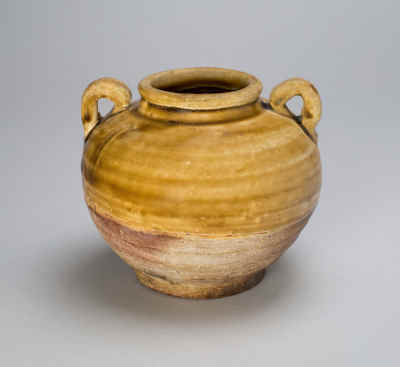How To Seal Pottery Without Glazing - Survival Manual

Glazed pottery does not have this issue but to glaze pottery takes very high temperatures not easily achieved by primitive lifestyles.
However, there are alternatives to glazing. These alternatives are called sealing. There are commercially available modern products you can buy to do this, but we will focus on primitive methods you can use safely and effectively.
One method that is almost as old as pottery itself is to use lard. To seal pottery with lard coat the pottery with lard and rub it in thoroughly, both inside and out. All the pottery to sit in the sun for a few hours. Then repeat two or even three times.
After this process there is one final step. Heat the lard treated pottery in an oven. This is to polymerize the lard and prevent it from ever going rancid. Once heated you are done.
Another ancient method is to use starches. Cornmeal for example. To use this method place the pottery with some clean water on a stove or grill for heating. Stir in copious amounts of cornmeal. Heat until it starts to bubble. Do this for a long time. Do not bring it to a roiling boil as that will not speed up the process and will just boil off the water faster. Stir occasionally as the pottery slowly bubbles. After boiling for a long time, pour out the contents and wipe clean. Allow to cool and you are done.
The last method is to use milk. Fill the bowl, jar, etc. with milk. Allow the milk to sit and seep into the walls of the vessel. Once the pottery has soaked in as much as you think it can, then pour out the milk wipe down completely and heat in oven to high temperature. In and around 375-450 degrees Fahrenheit. Allow to cool and you are done.
Food grade linseed oil is another option and probably the best. All that is needed for this method is to coat the pottery inside and out with linseed oil and let it set. No firing is needed. The linseed oil will polymerize at room temps and seal the pottery nicely.
As a final note to all of these processes. Before putting them to use, you should test with drinking water to see how well they do. Each method will work, but test and then repeat to process if they pottery is not sealed.
Test by allowing the water to sit for a few hours or overnight. Then, check to see if the outside of the pottery is wet or worse if there is actual liquid pooling under the pottery.
Don't dispare if the first iteration on sealing isn't a complete success. Just repeat until the results are satisfactory.
Check out this link to learn how to make your own pottery. Make Pottery
